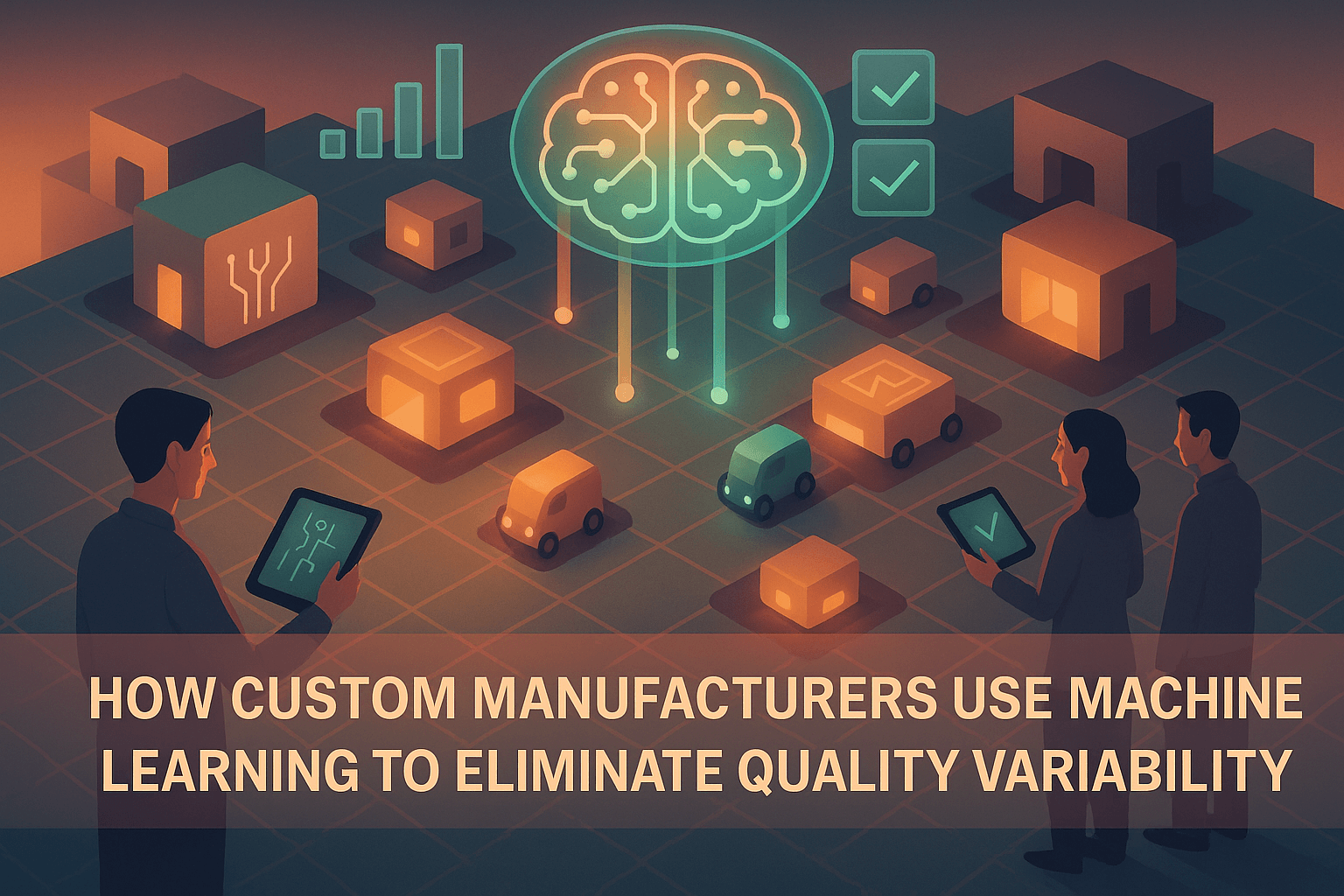The Root Cost of “Almost Right” in Custom Manufacturing
Most manufacturers lose money slowly—through invisible, compounding failures that bleed trust and margin over time. For those producing custom products, the slowest leak is variability.
You build a custom part. It’s not “wrong,” but it’s not exactly what the customer expected. A hole is off-center by 0.2mm. The finish isn’t consistent. A press-fit requires light sanding to work. The customer makes it work—but silently logs it as a problem.
You don’t get flagged. You don’t get a return. But you do lose something more valuable: repeatability and confidence. And over time, that erodes margin more aggressively than any tooling cost ever will.
This is the real economic threat of quality variability:
- Your team builds per spec, but the tolerances stack up across suppliers.
- You tighten QC, but now you’re inspecting everything and slowing throughput.
- You push for better machines, better operators, and more checklists—and still get edge-case failures.
The reality is this: custom work introduces custom failure modes. And you can’t inspect your way out of it. Because you’re not dealing with one problem, you’re dealing with a system of inputs that interact in ways humans aren’t fast enough to spot.
Most shops treat variability as a cost of doing business. The smart ones are starting to treat it like a data problem, because that’s what it is.
The new playbook doesn’t involve more inspectors or tighter tolerances—it introduces a machine learning system that applies intelligent pattern recognition across machines, materials, and methods.
This is where machine learning enters, not as a buzzword, but as the only scalable way to detect and eliminate quality drift before it reaches the customer.
Why Traditional Quality Control Can’t Scale with Customization
Quality control in most shops still relies on human judgment, tribal knowledge, and a checklist taped to the side of a machine. Maybe there’s a formal process, first article inspection, in-process checks, and final sign-off, but at the core, it’s built around consistency. And that’s exactly the problem.
Traditional QC is designed for repeatability. It works when you’re running the same part, with the same material, on the same setup, over and over again. In high-volume, low-mix environments, it’s good enough. But custom manufacturing doesn’t play by those rules.
Every job is different. Every customer spec is slightly tweaked. Material lots vary. Tolerances tighten without warning. One job requires cosmetic perfection; the next tolerates surface marks. The context shifts constantly, but the QC framework doesn’t.
Inspectors do their best, but they’re guessing what to measure more closely based on past failures. They don’t see what’s coming—they’re reacting to what’s already wrong. Worse, they’re inspecting the part, not the process. By the time a defect shows up in a part, the failure is already baked in. You’re just confirming it.
And here’s the real bottleneck: scaling QC with more complexity doesn’t scale. You can’t just throw more inspection steps, more CMM checks, or more people at the problem. You run out of time. You run out of margin. You create bottlenecks where you should be shipping.
This is where traditional thinking breaks. The assumption is, “If we measure more, we’ll catch more.” But in custom work, defects often arise from combinations of factors, not isolated anomalies. A slight change in material hardness, combined with a dulling tool, during a hot afternoon shift—those three factors might cause a defect that no one sees until the customer assembles the product and it doesn’t fit.
You can’t catch that with a caliper. You can’t checklist your way to insight.
Traditional QC reacts to bad outcomes. Machine learning technology flips the script by recognizing upstream patterns before failures occur. It learns from the full process—machine behavior, operator sequences, environmental variables—and starts recognizing when conditions are trending toward failure.
In high-variation manufacturing, the old QA model simply doesn’t scale. But pattern recognition does. That’s the shift.
Where Variability Hides — and Why Humans Can’t See It
The dangerous thing about variability is that it rarely announces itself. It doesn’t show up as a catastrophic failure. It shows up as subtle shifts. A thread that starts binding. A bore that’s within tolerance but causes field issues. A part that technically passes QC but ends up returned, remade, or revised.
These aren’t inspection failures. They’re detection blind spots. Because what causes variability isn’t always visible in the part itself. It’s hidden upstream—in the inputs, the environment, and the process drift. And by the time it shows up in the final product, you’ve already lost.
Consider what actually causes a part to go bad in a custom environment. It’s rarely one thing. It’s the interaction between things: a tool that’s halfway through its usable life, running on a batch of slightly different material, under a machine that ran hotter because the coolant filter wasn’t changed on time.
Humans don’t see those combinations. They don’t remember that the last three reworks all happened on parts cut with Tool 11 during the second shift. They don’t correlate a one-degree rise in ambient temp with surface finish issues. They’re too close to the process. Too in the weeds.
Machine learning sees what humans can’t: pattern clusters across noisy, imperfect, multi-dimensional data, often using unsupervised learning to surface unknown correlations before failures occur.
It doesn’t need perfect inputs. It just needs enough signals to start spotting correlations. And in custom manufacturing, those signals are already there—buried in spindle load logs, operator notes, inspection sheets, tool change data, and even maintenance schedules.
Let’s be clear: variability isn’t just in the part. It’s in the way the work is done. It’s how an operator sequences steps. It’s how one shift runs a bit faster and skips cleaning the fixture. It’s how a certain toolpath setting consistently yields slightly worse roundness on hardened stock.
None of this shows up in isolation. It only surfaces when you aggregate and correlate, exactly what ML does well.
And that’s the real threat: not that variability exists, but that it hides in plain sight. You’re bleeding money in rework, slowdowns, and customer distrust, not because your people don’t care, but because they can’t see the system holistically.
You don’t need more vigilance. You need a second set of eyes, trained to see what humans can’t track at scale. That’s the role of machine learning. Not to replace inspection, but to surface the invisible causes of variability that no checklist ever will.
Machine Learning Algorithms Behind the Predictions
The average custom manufacturer already has the data they need to eliminate most quality issues. They just don’t trust it, don’t organize it, or don’t use it for anything beyond retroactive blame.
Machine learning isn’t about inventing new data; it’s about applying effective data management to extract signal from the mess you already have. The shop floor is full of untapped indicators—tool wear logs, spindle RPM trends, rejection reasons scribbled on job travelers, and micro-adjustments made mid-run that never get documented.
The shift begins when you stop treating that information as “noise” and start feeding it into models built to learn from process behavior.
This isn’t about building some academic AI lab. It starts with a basic premise: can we detect, before the part fails, that something in the process is trending off-course?
You don’t need a neural network for that. You need structured data and a model that’s trained to recognize early signs of deviation. You’re not training a large language model to understand natural language; you’re training a lightweight system to recognize process patterns, equipment behavior, and real-world outcomes.
The actual implementation looks like this:
- Take historical data from past jobs and tag each run based on outcome—whether it passed, failed, got reworked, or was returned.
- Correlate those outcomes with upstream data: which machine ran it, how long the tool had been in service, what material lot was used, and what time of day it was produced.
- Feed that into a model powered by data analysis that uncovers statistical friction points, clusters of conditions that lead to bad parts.
From there, the model starts flagging patterns. Not theoretical ones. Real ones.
“This job failed when Tool #14 ran longer than 80 minutes without resharpening.”
“Surface finish problems increased by 30% when room temp > 75°F and coolant pump #2 was running.”
No human sees that in real time. No operator is connecting those dots across 500 jobs. The machine learning model does.
And once those patterns are visible, you gain leverage.
Now, instead of reacting to defects, you intervene upstream, changing settings, rerouting jobs, or alerting operators before the quality drops.
It’s not magic. It’s math. But the math only works if the data is clean, labeled, and trusted. Most shops don’t need more sensors. They need a workflow that turns messy logs into usable training data and a model simple enough to give you useful insight, not theoretical overkill.
You’re not trying to predict every bad part. You’re trying to spot where variability starts, so you can stop it before it compounds.
Human–ML Collaboration — Why This Doesn’t Replace Operators
The Fear: “Is This Just a Stepping Stone to Replacing Us?”
The moment machine learning enters the conversation, operators and floor managers get tense. Understandably so. The word “automation” in most industries has been code for “do more with fewer people.” But in custom manufacturing, that’s a misread.
You don’t get consistency by removing humans. You get it by amplifying their judgment with the kind of pattern recognition they can’t replicate at scale.
This isn’t about replacement. It’s about relevance in a high-complexity environment where the human brain alone just isn’t enough.
The Role Shift: From Firefighter to Process Controller
Operators spend most of their time reacting—chasing fit issues, chasing surface flaws, and trying to dial in a setup that was already drifting the moment they hit cycle start.
With ML, their role evolves. Instead of guessing what went wrong, they start to see what’s trending. They’re no longer responsible for memorizing tribal knowledge or hoping a 20-year vet walks by to help fix the chatter.
They become process controllers, people who know when to trust the model, when to intervene, and when to rerun a job with adjusted inputs because the data says it’ll fail before the part is even done.
That’s not job destruction. That’s job elevation.
The Collaboration: Judgment + Signal
Machine learning doesn’t understand tribal nuance. It doesn’t know why Shop B runs hot in July and likes to use his own indicators. That’s why the loop stays closed with human oversight.
Here’s how it looks in practice:
- The model flags a high likelihood of failure based on current setup parameters.
- The operator reviews the flagged inputs and confirms or overrides them.
- That decision gets logged, and the model learns from the override.
It’s not automated chaos. It’s a feedback system. And the human is still the final authority—but with far better visibility.
The Cultural Shift: From Blame to Curiosity
One of the most underrated impacts of ML on the floor is cultural. When quality issues arise, the first instinct in most shops is to assign fault: bad setup, wrong tool, careless operator.
But when the data starts surfacing interactions instead of isolated errors, blame loses its grip. Instead of “who missed this?” the question becomes “what pattern are we missing?” It becomes diagnostic instead of disciplinary.
That shift creates space for trust, experimentation, and improvement. And it builds a culture where quality is everyone’s job—not just inspection’s responsibility.
ML Doesn’t Need to Be Perfect — It Needs to Be Useful
Manufacturers often assume that if a machine learning model isn’t 99% accurate, it’s not ready. That assumption kills progress before it starts. In a world where everything is measured in tolerances, the natural instinct is to apply the same threshold to decision systems. But machine learning isn’t inspection; it’s early warning. It doesn’t need to be flawless to create real value. It just needs to be better than guessing.
Most quality systems operate on hindsight. You only know the part failed after someone catches it—or worse, after the customer does. That delay is where the real cost lives. A machine learning model, even one that’s only 70–80% accurate, shifts that timeline forward. It gives you the opportunity to course-correct before a defect becomes a shipment, a return, or a credibility problem.
Imagine a model that flags a job with a 75% likelihood of failure based on tool usage, material lot, and ambient temperature trends. Even if that flag turns out to be the wrong one out of four times, the ability to pause, inspect, or reroute that job can eliminate thousands in downstream cost. More importantly, it buys back control in a process that’s been ruled by reaction for too long.
The utility of machine learning isn’t in its precision. It’s in its foresight. Your team doesn’t lose judgment, they gain context. They stop reacting to defects and start managing risk proactively. They learn where variability begins, not just where it lands. The model doesn’t need to predict every bad part—it needs to help your team see the slope before it becomes a cliff.
A good model doesn’t make the right call every time. But it changes the conversation. Instead of asking, “What went wrong?” your team starts asking, “Why is this trending that way?” That shift—from blame to systems thinking—is worth more than any perfect prediction.
If you’re waiting for perfection, you’ll be waiting forever. But if you’re willing to act on insight before it’s obvious, you’re already doing more than most of your competitors.
Machine Learning for Custom Manufacturing Solutions
Machine learning sounds complicated because the industry insists on making it sound complicated. But you don’t need a PhD or a million-dollar custom platform to get started. You need structure, some curiosity, and the willingness to stop pretending that your current systems are catching everything. In most cases, the data you need is already sitting on your shop floor. You just haven’t looked at it the right way.
The first step is simple: pick one product, one process, or one recurring issue where variability is costing you. Not everything at once—just one thing. Maybe it’s a fitment issue on a custom housing that happens every few months, or inconsistent thread quality on a particular part made from tougher stock. Whatever it is, start there. Don’t touch the ML yet. Just collect six months of real data around that job. Every time it ran. What machine it ran on. What tool was used. What shift. Who the operator was. What material lot. What coolant settings. How long the cycle took. Whether it passed or failed.
If you already have this information in a digital format, good. If it’s still on traveler sheets or buried in operator notes, fine. You can digitize that manually. The point is to structure the chaos. You’re turning guesswork into labeled data. Pass/fail. Accept/reject. No drama. No ambiguity. Once you have that, you can move to the next step.
Now you bring in a basic machine learning model. You don’t need to build one from scratch. There are open-source tools, off-the-shelf ML platforms, or local consultants who can set up a classification model in a few hours. The goal isn’t to deploy some autonomous AI that takes over your floor. The goal is to train a model to recognize the conditions that lead to variation. Not just once, but over time. You’re building a model that learns from your process, not one that tries to replace it.
In most cases, your first model will be crude. It will find some correlations, miss others, and get a few things wrong. That’s not failure. That’s the baseline. The power is in what happens next: your operators, your process engineers, and your quality team begin to interact with those outputs. They validate some. They reject others. Every feedback loop sharpens the model. Every decision point becomes a data point. Over time, the system becomes a partner, not a tool.
And you don’t need to act on every insight right away. Maybe the model tells you that bore deviation spikes when the tool runs past 60 minutes—but you can’t change that immediately. Fine. You log it. You observe it. The next time it happens, you’re not surprised. You’re informed.
This is how machine learning becomes usable in real shops, not through disruption, but through gradual integration. You’re not turning your manufacturing floor into a tech company. You’re simply building a nervous system that helps you see what’s been hiding in plain sight. And you do it one variable, one model, and one win at a time.
Business Outcomes — From Quiet Losses to Controlled Processes
Most manufacturers don’t lose money in obvious ways. They lose it quietly—through rework that gets absorbed, through returns that get comped, through process drift that no one talks about but everyone works around. It doesn’t show up on the P&L. It shows up in customer hesitation, in margin erosion, and in the fatigue of constantly solving the same problems over and over.
Machine learning doesn’t just fix quality issues. It exposes where the business has been leaking value without noticing. When you eliminate variability, you don’t just build better parts. You change the dynamic with your customer. You stop delivering “good enough” and start delivering trust. That trust compounds. It turns into repeat orders, longer-term contracts, and referrals you didn’t ask for.
The internal shift is just as important. Your floor stops playing defense. Instead of reacting to the last defect, your team starts anticipating the next one. They spend less time in crisis mode and more time refining the process. Engineering decisions become data-backed. Quality meetings become proactive. Management stops wondering where the problems are because the system starts surfacing them on its own.
Margins begin to grow, not because costs went down, but because variability did. The amount of time, energy, and labor wasted on unpredictable output starts to shrink. Overtime hours drop. Rush shipments drop. WIP inventory gets tighter. The business becomes more predictable, and so does profitability.
And most importantly: you stop burning trust. Every rework, every missed tolerance, every “sorry we’ll get it right next time” takes a small piece of credibility with it. Machine learning gives you the ability to keep more of that credibility intact—because you’re catching what you used to miss.
The shops that invest here aren’t chasing hype. They’re tightening systems. They’re protecting trust. And in a market where custom manufacturers win by relationship and reliability, that edge becomes a moat.
Precision-First Toolkit for Custom Manufacturers Using Machine Learning
Stop chasing defects. Start preventing them, with machine intelligence tailored to high-mix, high-variance production.
Variability Source Mapping — Before You Touch ML
Use this table to isolate where quality inconsistency actually originates in your process. Most variability isn’t in the final part. It’s upstream.
| Process Element | Variability Signal You’re Likely Missing | How to Capture It |
| Tool Wear Patterns | Parts begin passing tolerance but require post-op tweaks | Tool usage logs + post-op adjustments |
| Material Lot Shifts | Surface finish or fit issues tied to specific vendors or batches | Tag lot #s to quality outcomes |
| Environmental Drift | Subtle roundness deviations on hot afternoons | Ambient temp and humidity sensors |
| Operator Technique | One shift requires fewer reworks than another | Operator ID tied to inspection results |
| Machine Behavior | CMM-passed parts returned from field due to functional issues | Spindle load, vibration, cycle time logs |
Before modeling, make the invisible visible. Even if it’s messy.
ML Deployment Readiness Audit
You don’t need a massive platform or AI department. You need traceable inputs and consistent outcomes.
| Readiness Checkpoint | Pass/Fail |
| Have you chosen a recurring job with known variation? | |
| Do you track pass/fail (or rework) at job level? | |
| Can you trace each job to inputs (tool, machine, material)? | |
| Do you have at least 50–100 runs to start with? | |
| Can you export or digitize historical process logs? |
If you get 3+ yeses, you’re ready to pilot ML with a focused use case.
Real-World ML Triggers to Configure
Set meaningful alerts that help your floor team act before defects happen — not just after they’re inspected.
| Trigger Condition | Action |
| Tool usage > 60 mins on hardened stock + high ambient temp | Flag setup for inspection or adjustment |
| Same operator, same machine, 3 reworks in a row | Escalate to engineering for deeper process review |
| Vibration profile deviates from known “good” band | Alert maintenance or reroute job |
| Known material lot + long cycle time = historical finish issue | Prompt alternate finishing method or material validation step |
| Operator override of ML alert > 3x/week | Schedule model tuning session with team |
These aren’t theoretical. They reflect real variability signals your team already suspects — but can’t track manually.
Metrics That Actually Reflect ML ROI (Not Just Buzzwords)
You’re not trying to get a perfect prediction. You’re trying to reduce repeat problems.
| Metric | What It Shows |
| First-pass yield improvement (by job) | ML prevented early-stage rework |
| Preemptive intervention rate | ML flagged issues before final inspection |
| Operator-to-model trust ratio | How often humans override alerts vs. accept them |
| Model correction loop velocity | How fast your model adapts to new inputs or outcomes |
| % reduction in repeat field complaints | Real-world confirmation that variability was addressed |
Don’t just track how many parts pass — track how many problems were prevented.
Operator Enablement — Not Replacement
This is how the human/ML loop works in high-mix manufacturing:
| Human Judgment | ML Support Role |
| “This fixture always gives us weird chatter” | Confirms pattern across runs and shifts |
| “Tool seemed sharp but part failed again” | Flags tool-based patterns invisible to operator |
| “I adjusted spindle speed last time, and it fixed it” | Logs adjustment and feeds new input into next run |
| “We had extra humidity that day” | Tracks environmental correlation to failures over time |
Good models don’t override floor knowledge. They surface what the floor doesn’t have time to track.
Pilot Plan Template (Simple + Tactical)
| Step | What You Actually Do |
| Choose a recurring quality issue | E.g., slight ovality in bore when run on Machine 4 |
| Structure 3–6 months of run data | Tool ID, machine, operator, pass/fail, material lot |
| Label outcomes consistently | Even just pass/rework/return |
| Run a simple classification model | Use local vendor, open-source tool, or low-code platform |
| Review early predictions with team | Validate usefulness before triggering shop-wide alerts |
| Build human-in-the-loop workflow | Operator sees predictions, confirms or overrides |
You’re not launching a system. You’re building intuition at scale.
Variability Isn’t a Manufacturing Problem. It’s a Data Problem.
Every shop talks about quality. Every team thinks they’re catching most issues. But in custom manufacturing, variation is not just a matter of skill. It’s a matter of visibility. And most of the time, the real cause of variability isn’t on the surface. It’s buried in the data you never connected—until the part fails and the customer calls.
The truth is this: you’re not fighting defects. You’re fighting opacity. Variability looks like a machining problem, a material issue, or an operator miss. But more often, it’s a failure to detect the pattern early enough. That makes it a data problem.
Machine learning doesn’t fix bad parts. It doesn’t magically make your tolerances tighter. What it does is show you where the process starts to slip before anyone else notices. It turns tribal knowledge into structured feedback. It lets your team act earlier, adjust faster, and learn in ways that don’t depend on someone remembering how things went wrong last time.
Most manufacturers still think more inspection is the answer. It isn’t. The answer is better insight.
If you can model where quality breaks down, you can control it. If you can control it, you can scale it. And if you can scale consistent output—without burning labor or trust—you build something your competitors can’t touch.
This isn’t about buzzwords. It’s not about being “innovative” or “digital.” It’s about getting serious about what’s costing you—quietly, slowly, every day.
Machine learning isn’t the future. For smart custom manufacturers, it’s already part of the operating system.
The only question left is whether you’ll keep trying to inspect your way out of variability—or start seeing it before it happens.
If you’re ready to see your process more clearly, reduce variation, and build with confidence, we’d love to help.
Contact us and let’s explore how data and machine learning can give your team the visibility it needs to move faster, smarter, and with fewer surprises.











